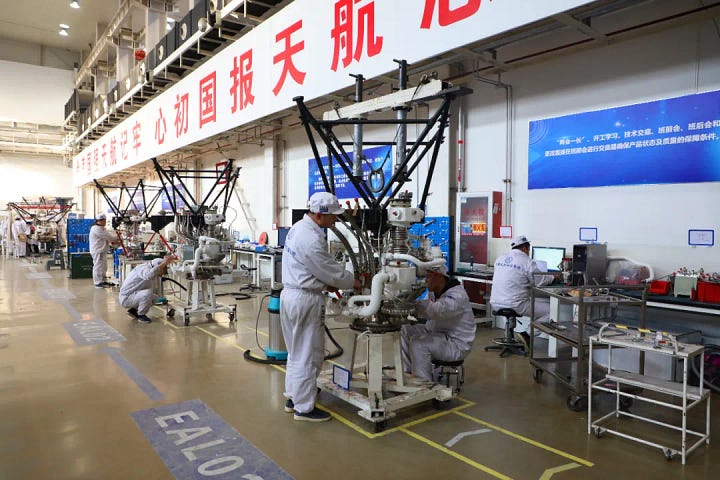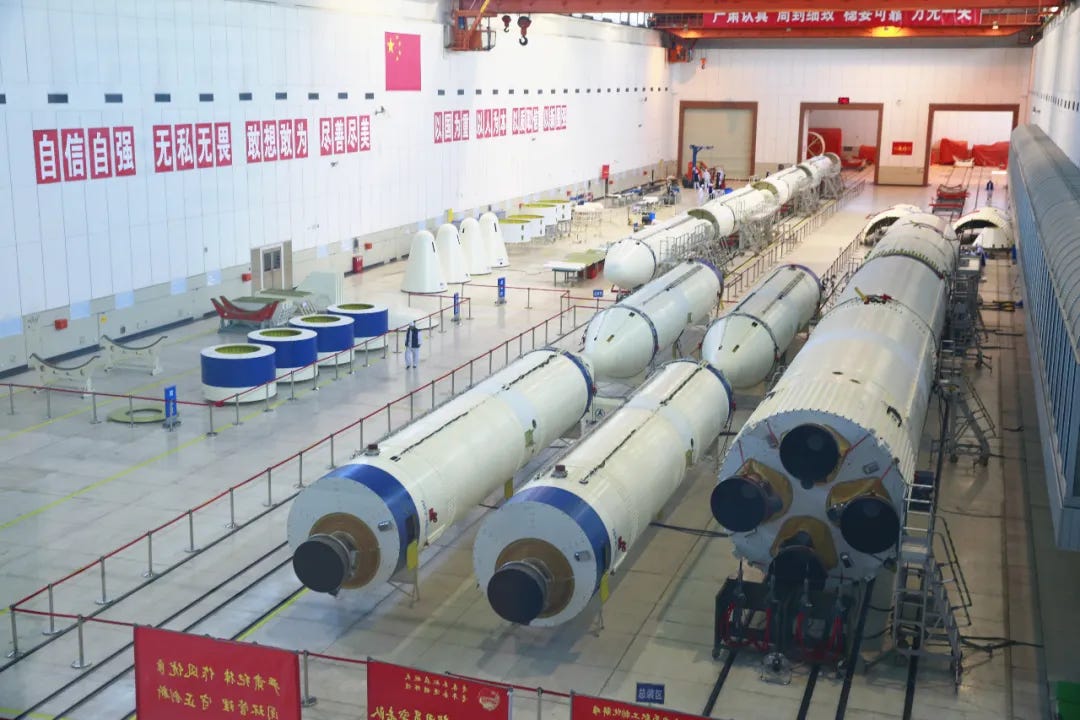New Methane Engine Fires and New Discoveries in Deep Space
New goals for 2025 are imminent as more progress and discoveries are made.
Ahead of China’s Two Sessions this year and the likely release of the China Aerospace Science and Technology Corporation’s 2025 ‘Blue Book’ which will outline the space sector’s goal for the year, various companies are pushing hardware through testing and scaling up manufacturing. Additionally, experiments aboard the Tiangong Space Station are progressing, including one involving a robot, along with discoveries by the Einstein Probe.
JZYJ verifies Longyun-70V engine
Jiuzhou Yunjian (九州云箭), often shortened to just JZYJ, announced on February 26th that it had successfully completed a test of its Longyun-70V engine. Longyun-70V is a vacuum-optimized version of the liquid methane and liquid oxygen burning Longyun engine.
According to the company, the engine has passed over a thousand seconds of cumulative firing tests. Through the testing, the design and reliability were verified to be within the expected specifications. JZYJ also added that the testing verified the engine’s adaptability to supercooled propellants.
Several customers are expected to use the Longyun-70V engine with currently in-development partially reusable launch vehicles. One such customer is the Shanghai Academy of Space Technology with either the Long March 12A or 12B.
Wenchang Commercial phase two contractors sign-on

On February 25th, the Hainan International Commercial Aerospace Launch Co., Ltd. (海南国际商业航天发射有限公司), often shortened to HICAL and operator of the Wenchang Commercial Space Launch Site, announced that various contractors had signed on for phase two of construction at the Wenchang Commercial Space Launch Site. Representatives of the Wenchang Municipal Government, HICAL, and the contractors were in attendance at the signing of the agreements.
According to the announcement, eight contractors will work on various sub-projects across the launch site during construction. These sub-projects are expected to be for systems that support launches from the two launch pads that are being constructed. All contractors are reported to have agreed to follow the requirements of:
“Accurately match the project needs, form a professional work team, strengthen technical control, and build a benchmark project in the aerospace field with high quality, high standards and high efficiency with full enthusiasm, an open and collaborative attitude and a spirit of active learning, so as to contribute to the development of the country's commercial aerospace industry.”
If there are any problems with this translation please reach out and correct me.
The signing on of the contractors comes one month after the second phase of development at the launch site was officially kicked off. This phase will see the liquid propellant multi-user Commercial Launch Pads 3 and 4 completed before 2027.
Also on February 25th an emergency deluge test was performed on Commercial Launch Pad 1, which will support the Long March 8 series of launch vehicles.
This test had a few hundred cubic meters of water poured across the launch platform and flame diverter. The purpose of the test was to demonstrate how fast the emergency system can douse the launch platform with water in the event of an incident leading up to the launch. As this test was for emergency procedures, all of the launch pad service platforms were still in position for accessing a rocket, no vehicle was present for the test however.
So far no launches have occurred from Commercial Launch Pad 1 due to various delays with the payloads of two Long March 8 launch vehicles currently at the launch site. At the time of writing the first launch from the Commercial Launch Pad 1 could occur in the first half of March.
Long March 3A series & YF-75 production expands
Capital Aerospace Machinery Co. Ltd. (首都航天机械有限公司), a key manufacturer for the Long March series of launch vehicles, shared on February 26th that its production capacity reached a new high following the Chinese New Year. Mainly for the Long March 3A series of launch vehicles and for the YF-75 engines.
Regarding the Long March 3A series of launch vehicles (which consists of the Long March 3A, 3B, and 3C), the company has expanded production efforts to work on three vehicles in parallel. Working on three vehicles in parallel is needed to meet the growing launch cadence of the Long March 3B/E throughout this year and next year. The company also added that two Long March 3B/E’s are being assembled while one is undergoing factory testing at present.
Additionally, Capital Aerospace Machinery has scaled up manufacturing efforts for the YF-75 series of engines. Citing a desired double in production needs, fourteen workshops are working on assembling and manufacturing YF-75 engines, with various engine units worked on in parallel. To meet engine demands, production efficiency has increased by a stated one hundred and thirty percent.


CAS-ESA Einstein Probe detects unusual celestial pair
The joint Chinese Academy of Sciences-European Space Agency Einstein Probe has been in orbit for just over a year and is already making discoveries.
In late February, the European Space Agency shared that the Wide-field X-ray Telescope on the Einstein Probe spotted X-rays coming from the Small Magellanic Cloud. These X-rays were coming from a new source labeled EP J0052. Additionally, Alessio Marino, a researcher at the Institute of Space Sciences in Spain, explains:
“We were chasing fleeting sources, when we came across this new spot of X-ray light in the Small Magellanic Cloud. We realised that we were looking at something unusual, that only Einstein Probe could catch,” — “We soon understood that we were dealing with a rare discovery of a very elusive celestial couple” — “The unusual duo consists of a massive star that we call a Be star, weighting 12 times the Sun, and a stellar ‘corpse’ known as a white dwarf, a compact and hyper-dense object, with a mass similar to that of our star.”
The European Space Agency also states that the two stars closely orbit each other, and the white dwarf’s intense gravitational field pulls matter from its companion. As more and more material rains down on the compact object, its strong gravitation compresses it, until a runaway nuclear explosion is initiated. This creates a bright flash of light across a wide range of wavelengths from visible light to UVs and X-rays.
Speaking to China Daily, Yuan Weimin, the Einstein Probe's principal investigator, added:
“The discovery opens a new way to explore how massive stars interact and evolve, confirming the unique power of the mission to uncover fleeting X-ray sources in the sky,” — "We hope the Einstein Probe satellite will continue to drive advancements in high-energy time-domain astronomy"
Back in January, it was announced that the spacecraft had successfully been detecting a series of X-ray bursts. This proved that the spacecraft’s software triggers for monitoring bursts were working as expected.
Liu Yang spoke at the UN
Veteran taikonaut Liu Yang (刘洋), of the Shenzhou-9 and Shenzhou-14 missions, recently spoke at the 58th session of the UN Human Rights Council via video link. The speech was part of a panel discussion themed on “commemorating the thirtieth anniversary of the Beijing Declaration and Platform for Action adopted at the Fourth World Conference on Women”. According to Spokesperson Lin Jian (林剑) of China’s Foreign Ministry, the details are as follows:
“This year marks the 30th anniversary of the World Conference on Women in Beijing. On February 24, according to the resolution jointly proposed by China and relevant countries, a panel discussion themed on “commemorating the thirtieth anniversary of the Beijing Declaration and Platform for Action adopted at the Fourth World Conference on Women” was held at the 58th session of the UN Human Rights Council in Geneva. Several female heads of U.N. agencies delivered remarks as panelists. Liu Yang, China’s first female astronaut in space, delivered a keynote speech via video link as a representative of outstanding women in the world, sharing China’s visions and achievements in the high-quality development in women’s cause in the new era. In her speech, Liu Yang noted that she is a beneficiary and practitioner of the spirit of Beijing Declaration, and as well as a witness of women empowerment through technology. When the engine of the Shenzhou spacecraft was ignited, she felt not only the shock of 600 tonnes of thrust, but also the power of hundreds of millions of Chinese women backing it up. The concept that “standards know gender in the selection and training of Chinese astronauts” reflects the core logic of women’s cause in China, that is to institutionalize a fair and equitable competition environment for both men and women. This is also a concrete realization of the spirit of the Beijing Declaration.”
Cai Xuzhe passes 300 days in space
As part of the ongoing Shenzhou-19 mission, Cai Xuzhe (蔡旭哲) has surpassed 300 accumulated days in space. This mission, which he is commanding, is Cai’s second mission, having spent almost 182 days in space for the Shenzhou-14 mission back in 2022.
So far Ye Guangfu (叶光富), of the Shenzhou-13 and Shenzhou-18 missions, is the only other taikonaut to achieve 300 accumulated days in space, passed the milestone in August 2024. Ye’s total time in space to just over 374.5 days, with Cai expected to reach a similar total time when he returns to Earth in late April.
For some information on Cai’s background, he is from Shenzhou (深州市), in Hebei province (河北), and has served in the People's Liberation Army Air Force. In 2010 he was selected as part of the second group of taikonauts. After the Shenzhou-14 mission, Cai was awarded the honorary title of "Heroic Astronaut" in March 2023.
Pipeline robot tested onboard Tiangong
Xinhua reported, on February 25th, that the Shenzhou-19 crew has recently completed tests of a pipeline inspection robot onboard the Tiangong Space Station. Reports of early tests of the robot were shared back in mid-January.
According to the report, the robot conducted tests in a simulated pipeline to assess its mobility and processes. During the test the robot is said to have demonstrated stable and reliable movement through various types of pipelines, validating its autonomous mobility technology designed to suit multiple complex pipeline structures. Additionally, the robot could be easily extracted from complex pipelines even after a power outage. The robot also monitored its position and status to ensure it did not become stuck.
Along with testing the robot, the Shenzhou-19 crew (consisting of Cai Xuzhe (蔡旭哲), Wang Haoze (王浩泽), and Song Lingdong (宋令东)) has been completing various other experiments onboard Tiangong. Via China Daily, the crew has conducted research on how exercise impacts muscles and bones in microgravity, completed vascular ultrasound examinations to explore the pan-vascular network blood flow patterns in the weightless environment, and completed eye tests to allow researchers to develop a strategy for maintaining eye health during longer duration missions.



